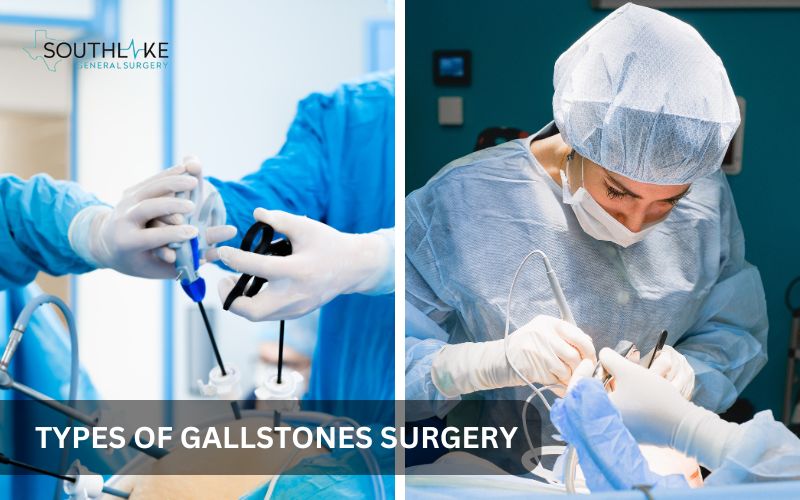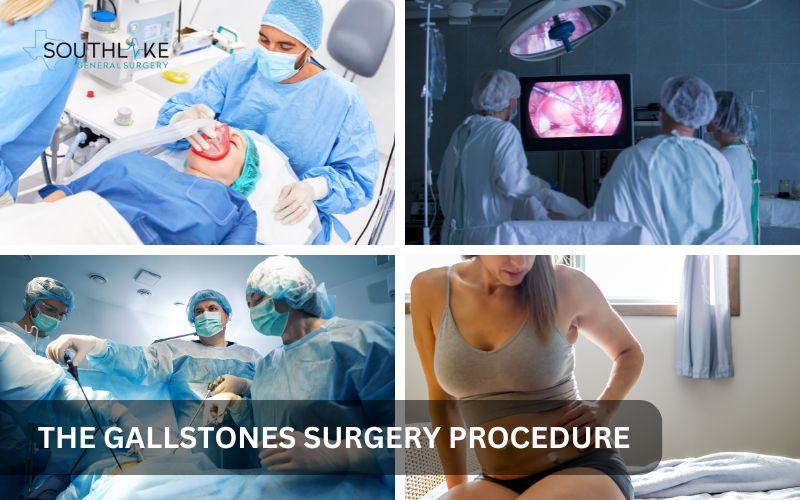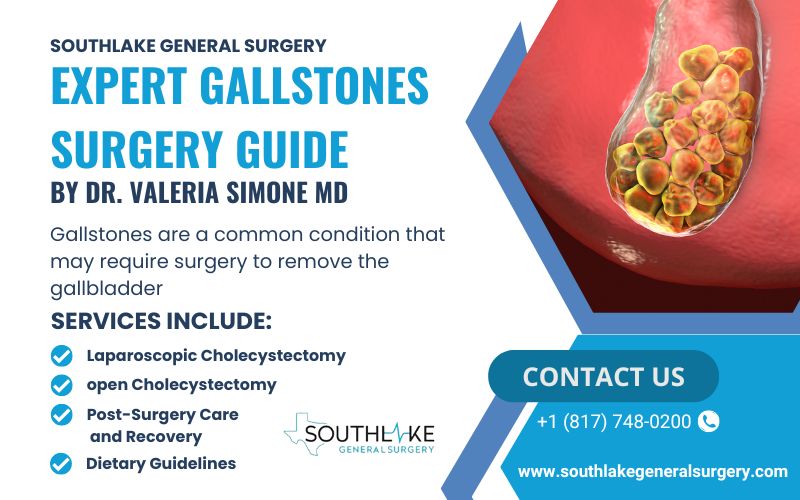Gallstones surgery by Dr. Valeria Simone MD, is a comprehensive guide to the surgical treatment of gallstones. Gallstones are a prevalent issue that impacts a substantial number of individuals globally.
If symptoms or complications arise from gallstones, surgical intervention may be required to remove the gallbladder.
In this comprehensive guide, we will provide you with all the information you need to know about gallstones surgery, including the types of surgery offered, the preparation process, the surgical procedure itself, post-surgery care and recovery, as well as the risks and complications involved.
Dr. Valeria Simone, a renowned expert in gallstones surgery, will share her insights and expertise to help you understand the process and make informed decisions about your treatment.
Whether you are considering gallbladder surgery or have already scheduled your procedure, this guide will serve as a valuable resource to guide you through every step of the process.
We hope that this guide will answer all your questions and provide you with the knowledge and confidence you need for a successful gallstones surgery.
Key Highlights
- Gallstones are a common condition that may require surgery to remove the gallbladder.
- The most common reason for gallbladder surgery is the presence of gallstones, which can cause pain and other complications.
- Gallbladder removal surgery can be performed using laparoscopic or open techniques.
- Laparoscopic cholecystectomy is a minimally invasive procedure that involves making small incisions and using a camera and surgical tools to remove the gallbladder.
- Open cholecystectomy is a traditional surgery that involves making a larger incision to access and remove the gallbladder.
- Recovery after gallbladder surgery is usually quick, and most people can resume normal activities within a few weeks.
Understanding Gallstones and the Need for Surgery
Gallstones are hard deposits that form in the gallbladder, a small organ located under the liver. They can vary in size from small particles to larger spheres. Gallstones can be made up of cholesterol or pigments, and they can cause pain and other complications when they block the flow of bile.
Surgery may be necessary to remove the gallbladder when gallstones cause symptoms or pose significant risks to a person’s health.
Cholecystectomy, also referred to as gallbladder surgery, is a frequently conducted surgical procedure that is prevalent worldwide. It can provide relief from the symptoms of gallstone disease and improve a person’s quality of life.
What Are Gallstones?
Gallstones are hard deposits that form in the gallbladder, a small organ located under the liver. Further, gallstones can be classified into two main categories: cholesterol stones and pigment stones.
The most prevalent type of stones are cholesterol stones, typically displaying a yellow-green hue. They consist of cholesterol and other substances present in bile.
On the other hand, pigment stones are generally smaller in size and possess a darker hue. They are made up of bilirubin, a substance produced when the liver breaks down red blood cells.
Gallstones come in a range of sizes, from tiny grains of sand to large golf ball-sized ones. They can cause pain and other symptoms when they block the flow of bile, leading to a condition known as gallstone disease or gallbladder disease.
Symptoms Indicating Gallstone Surgery Is Necessary
Gallstone surgery may be necessary if the symptoms of gallstones become severe and interfere with daily life. One of the most common indicators for surgery is a gallbladder attack.
During a gallbladder attack, individuals may experience intense and persistent pain in the upper abdomen, often radiating to the back or shoulder. The pain may be accompanied by nausea, vomiting, and fever.
Sharp pain in the upper right abdomen, particularly after consuming a fatty or greasy meal, is another symptom that may necessitate gallstone surgery.
This pain can be a sign that a gallstone is blocking the bile duct, causing bile to accumulate in the gallbladder and leading to inflammation and infection.
If these symptoms occur, it is essential to seek medical attention promptly. A healthcare provider can evaluate the severity of the gallbladder disease and determine if surgical intervention is necessary to remove the gallstones and alleviate symptoms.
Types of Gallstones Surgery Offered by Dr. Valeria Simone

Laparoscopic cholecystectomy is a minimally invasive surgery involving small incisions and a tiny video camera.
Open gallbladder surgery, known as an open cholecystectomy, requires a larger incision and general anesthesia.
Dr. Valeria Simone offers both options based on individual patient needs and preferences. The laparoscopic approach typically results in less pain, faster recovery time, and fewer complications compared to open surgery.
Patients can discuss the most suitable option during their consultation with Dr. Simone.
Overview of Laparoscopic Cholecystectomy
A laparoscopic cholecystectomy is a procedure that is performed using minimally invasive surgical methods to remove the gallbladder. It involves making several small incisions through which a tiny video camera and specialized surgical tools are inserted.
This technique allows for a quicker recovery time, less pain, and a shorter hospital stay compared to open surgery.
The surgeon inflates the abdomen with carbon dioxide gas to better visualize the gallbladder and surrounding organs during the procedure, facilitating precise and efficient surgery.
Insights into Open Gallbladder Surgery
Open gallbladder surgery, also known as open cholecystectomy, involves a larger incision compared to laparoscopic surgery. This procedure is performed under general anesthesia. During open surgery, the surgeon directly accesses the gallbladder to remove it.
Although it may require a slightly longer recovery time than laparoscopic surgery, open cholecystectomy is still a safe and effective treatment option for certain patients.
Understanding the differences between open and laparoscopic approaches can help you make an informed decision about your gallstones surgery.
Preparing for Your Gallstones Surgery
Ensure readiness for your gallstones surgery by undergoing an initial consultation and evaluation with Dr. Simone. Follow pre-surgery instructions and dietary guidelines diligently to optimize your preparation for the procedure.
Being well-prepared mentally and physically can positively impact your overall surgical experience and recovery.
Dr. Simone’s expertise and guidance will help you navigate this phase smoothly, ensuring you are well-prepared for a successful gallstones surgery.
Initial Consultation and Evaluation with Dr. Simone
During your initial consultation with Dr. Simone, a thorough evaluation will be conducted to assess the necessity of gallstones surgery.
Dr. Simone, a specialist in gallbladder surgery, will review your health information and perform a full physical examination to tailor the treatment to your specific condition.
This crucial step ensures that you receive personalized care and the best possible outcome for your gallstone disease. Dr. Simone’s extensive expertise and years of experience at Southlake General Surgery in Texas ensure a thorough assessment.
Pre-Surgery Instructions and Dietary Guidelines
Before gallstones surgery, adhere to pre-surgery instructions diligently. Follow dietary guidelines set by Dr. Valeria Simone to optimize surgical outcomes.
The Gallstones Surgery Procedure Explained

On the day of your gallstones surgery, you will undergo a specialized procedure either through laparoscopic or open surgery. Under general anesthesia, small incisions will be made for the insertion of surgical tools and a tiny video camera to guide the surgeon.
The gallbladder is carefully removed, and if needed, stones from the bile duct are extracted. Carbon dioxide gas is used to inflate the abdomen for better visibility Experience a shorter recovery period and reduced pain with the laparoscopic method.
Surgery Day Preparation: What to Expect
Upon arrival at Southlake General Surgery for your gallstones surgery, you will undergo pre-operative preparation, including signing consent forms. Once in the operating room, you will be administered general anesthesia.
Under Dr. Simone’s expertise, the surgery will commence with small incisions for laparoscopic gallbladder removal. Expect a procedure involving a tiny video camera and surgical tools inserted through these incisions.
It is usual practice to use carbon dioxide gas to improve visibility. Post-surgery, you will be monitored in the recovery room before being discharged the next day.
Step-by-Step Guide Through the Surgical Process
The surgical process of gallstone operation typically involves several key steps.
- Firstly, you will be placed under general anesthesia for the procedure.
- Next, small incisions will be made in your abdomen to access the gallbladder. A tiny video camera will guide the surgeon in viewing the gallbladder on a monitor.
- Surgical tools will be used to carefully remove the gallbladder. Carbon dioxide gas may be used to inflate the abdomen for better visualization.
- Finally, the incisions will be closed, and you will be monitored closely before being allowed to recover.
Post-Surgery Care and Recovery

Immediately after gallstones surgery, proper post-operative care is crucial for a smooth recovery. At Southlake General Surgery, post-op care includes close monitoring of vital signs and pain management. Dr. Valeria Simone emphasizes the importance of following all prescribed medications and instructions.
Patients are advised to gradually resume normal activities while staying hydrated and maintaining a healthy diet.
Home recovery guidelines will be provided, and scheduled follow-up appointments will ensure the healing process is progressing as expected. Your well-being post-surgery is our top priority.
Immediate Post-Op Care at Southlake General Surgery
Following gallstones surgery at Southlake General Surgery, immediate post-op care is vital. Our highly skilled team provides individualized care and constant supervision in a welcoming environment.
Patients receive detailed instructions for at-home care, pain management, and potential signs of complications.
With a focus on your well-being, we prioritize a smooth recovery process, guiding you through this crucial phase with expertise and compassion.
Rest assured, your health and comfort are our top priorities during this critical period.
Home Recovery Tips and Follow-up Care
Following gallstones surgery, prioritize rest and hydration.
- Stick to light, easily digestible meals.
- Incorporate gentle physical activity gradually.
- Maintain cleanliness and dryness of incisions, adhering to specific care instructions.
- Monitor for any unusual symptoms post-surgery.
- Adhere to the recommended schedule of follow-up appointments as instructed by your healthcare provider.
If you experience persistent pain or concerning issues during your recovery, promptly contact your healthcare team for guidance and support.
Home recovery is crucial for a smooth recuperation process. Remember to follow all post-operative care guidelines diligently.
Risks and Complications of Gallstones Surgery
Gallstones surgery, while generally safe, carries inherent risks and potential complications. These can include infection, bleeding, bile duct injury, or even a rare occurrence like bile leakage. Additionally, there’s a possibility of anesthesia-related issues or the formation of new stones post-surgery.
Understanding these risks and promptly addressing any concerns with your healthcare provider is essential for a successful outcome.
Remember, thorough pre-operative preparation and post-operative care can significantly mitigate these risks.
Common Surgical Risks and How They Are Mitigated
During gallstones surgery, potential risks include infection, bleeding, and injury to the bile duct. Dr. Valeria Simone ensures safety by using advanced laparoscopic techniques.
These methods minimize complications and promote faster recovery. Utilizing smaller incisions results in reduced pain and a shorter hospital stay for patients.
Additionally, Dr. Simone’s expertise in gallbladder surgery significantly reduces the risk of postoperative complications. Through meticulous care and precision, common surgical risks are effectively managed for a successful outcome.
When to Seek Immediate Medical Attention Post-Surgery
Following gallstones surgery, seek immediate medical attention if you experience:
- persistent fever
- severe abdominal pain
- excessive bleeding, or
- symptoms of infection, including redness, warmth, or swelling around the site of the incision
Any difficulty in breathing, chest pain, or jaundice warrants prompt medical evaluation to prevent complications.
Additionally, sudden nausea or vomiting, uncontrolled shivering, or persistent dizziness should not be ignored and must be reported to your healthcare provider immediately.
Your well-being post-surgery is crucial; do not hesitate to seek help for any concerning symptoms.
Adjusting to Life Without a Gallbladder
Adjusting to life without a gallbladder may require dietary changes and careful management of digestive health.
Since the gallbladder plays a role in storing and releasing bile to aid in digestion, individuals post-gallbladder surgery may experience changes in how their body processes fats.
It is essential to follow guidelines provided by medical professionals for maintaining a balanced diet and managing any potential digestive issues that may arise. Regular follow-ups with healthcare providers can ensure long-term health and wellness without a gallbladder.
Dietary Changes and Managing Digestive Health
Patients undergoing gallbladder removal surgery need to adapt to dietary changes for optimal digestive health. Post-surgery, a low-fat diet is recommended to aid digestion and prevent discomfort.
Consuming smaller, frequent meals can also assist in managing digestive issues. A diet rich in fruits and vegetables, which are high in fiber, can help people maintain regular bowel movements.
Consume plenty of water and pay attention to your body when it tells you when it can no longer tolerate certain foods.
Maintaining digestive health after surgery is made much easier by controlling food choices.
Long-term Health and Wellness without a Gallbladder
Managing long-term health and wellness after gallbladder removal requires adjusting to dietary changes and monitoring digestive health. The body can continue to operate normally in the absence of a gallbladder; however, some people may notice a change in their bowel habits.
It is crucial to follow post-surgery guidelines and maintain a healthy lifestyle. While the gallbladder is an essential organ, its absence generally does not significantly impact long-term health or quality of life if proper care is taken.
Outlook
Patients undergoing gallstones surgery can expect a positive outlook post-recovery. With advancements in medical technology, procedures like laparoscopic cholecystectomies offer quicker recovery times and minimal scarring.
Dr. Valeria Simone MD ensures a comprehensive approach to post-operative care, guiding patients towards a healthy lifestyle without their gallbladder.
Regular follow-ups and adherence to dietary recommendations aid in a smooth transition, allowing individuals to resume normal activities relatively soon.
The outlook after gallstones surgery is generally favorable, promoting improved digestive health and overall well-being.
Make An Appointment
To arrange a consultation or obtain further information regarding gallstone surgery, please get in touch with Dr. Valeria Simone MD at Southlake General Surgery in Texas, USA.
To schedule an appointment and receive specialized care for gallbladder-related conditions, contact us at +1 (817) 748-0200.
Whether you require gallbladder removal or have questions about recovery and post-operative care, Dr. Simone specializes in providing comprehensive treatment for gallstone disease.
Frequently Asked Questions
Can Gallstones Recur After Surgery?
Gallstones can recur after surgery, although they’re not common. Factors like incomplete gallstone removal or the formation of new stones may lead to a recurrence. Regular check-ups and following post-surgery guidelines can help prevent this.
Is gallstone surgery a major operation?
Gallstone surgery, whether laparoscopic cholecystectomy or open gallbladder surgery, is considered a major operation due to the removal of the gallbladder. While minimally invasive, it still requires anesthesia and recovery time. Understanding its significance is crucial for those undergoing this procedure.
Is surgery necessary for a gallstone measuring 1.76 cm?
Gallstone surgery may be necessary for a 1.76cm gallstone due to the risk of complications like blockages or inflammation. Consultation with a healthcare provider is crucial to determine the best course of action based on individual factors.
Medically Reviewed By: Dr. Valeria Simone MD
Board-certified General Surgeon at Southlake General Surgery, Texas, USA.
Follow us on Facebook and YouTube.
References:
- Abraham, Sherly, et al. “Surgical and Nonsurgical Management of Gallstones.” AAFP, 15 May 2014, www.aafp.org/pubs/afp/issues/2014/0515/p795.html.
- Noble, Fergus, and Colin Johnson. “Gallstones.” Medicine, vol. 43, no. 11, Nov. 2015, pp. 689–93. https://doi.org/10.1016/j.mpmed.2015.08.006.
- Gutt C, Schläfer S, Lammert F. The Treatment of Gallstone Disease. Dtsch Arztebl Int. 2020;117(9):148-158. doi:10.3238/arztebl.2020.0148
- Anesthesia. medlineplus.gov/anesthesia.html.
- Gallbladder removal – laparoscopic – discharge: MedlinePlus Medical Encyclopedia. medlineplus.gov/ency/patientinstructions/000117.htm.
- Gallbladder removal – open – discharge: MedlinePlus Medical Encyclopedia. medlineplus.gov/ency/patientinstructions/000118.htm.
- Ursodiol: MedlinePlus Drug Information. medlineplus.gov/druginfo/meds/a699047.html.
- “—.” National Institute of Diabetes and Digestive and Kidney Diseases, 30 Aug. 2022, www.niddk.nih.gov/health-information/digestive-diseases/gallstones/treatment.
- National Institute of Diabetes and Digestive and Kidney Diseases, 22 Feb. 2024, www.niddk.nih.gov/health-information/digestive-diseases/gallstones/definition-facts.

